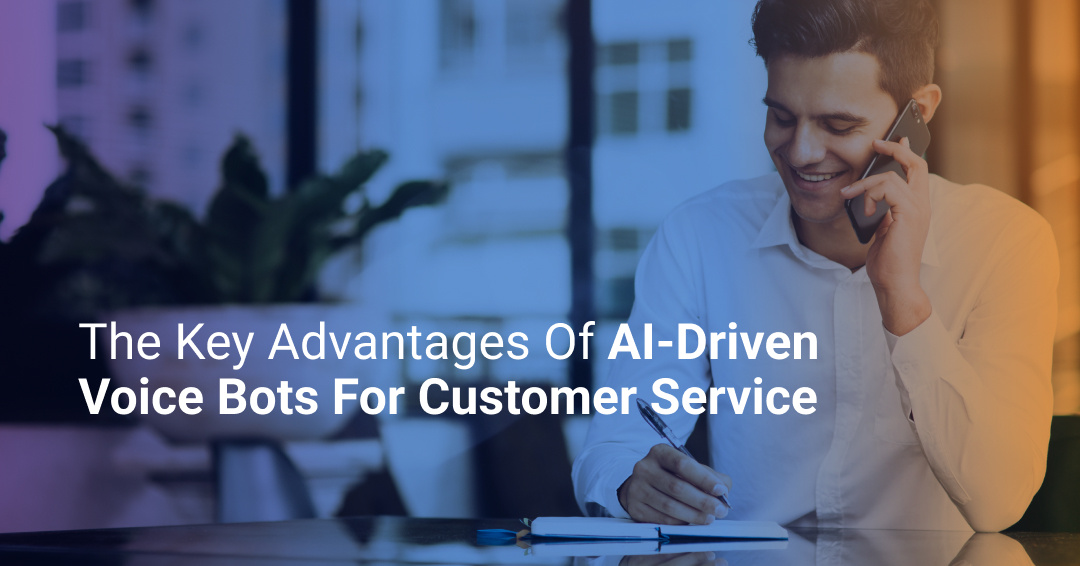What's CSAT Score? How to Measure and Improve It
Businesses across industries have changed or evolved over the decades, but one thing that has remained the same is that their growth is pretty much...

When it comes to customer interactions, voice matters. Customers like to feel that their requests are understood when they contact customer support. Some stakeholders believe that only human contact center agents can genuinely understand and provide effective support.
However, modern virtual agents that leverage AI can deliver near-human support. Excellent voice recognition and AI result in an intuitive, intelligent voice technology solution that provides human-like responses. Businesses looking to implement voice technology should do careful research when selecting contact center technology, as not all can deliver voice recognition and AI well.
This blog details how AI-powered intelligent virtual agents (IVAs) help businesses manage high-call volumes, provide better service, and evolve with customers to improve the overall customer experience.
Did you know that 69% of people prefer to use phone calls over chat or other support channels? Along with phone support, today's customer service demands also include a desire for personalization, 24-hour service, and fast resolution times. These preferences, combined with increased call volumes and staffing shortages, present a need for contact center automation.
For companies experiencing labor shortages, high call volumes, or simply wanting to keep pace with customer demands, IVAs can help. Virtual agents that leverage voice technology capabilities like natural language processing help businesses provide support in a customer's preferred channel. Customers’ communication preferences vary and evolve. A contact center's ability to provide technology that facilitates support in various channels helps improve customer experience and makes the business more resilient as demands change.
However, for virtual agents to be effective, they need to be able to understand and speak like humans. Today's voice technology is sophisticated and can converse with customers in a way that is indistinguishable from human-to-human interactions. Below, we dive into what makes IVAs human-like, and the different types of contact center voice technology that can boost overall CX.
Natural language processing (NLP) is a branch of AI that helps computers comprehend, interpret, and manipulate human language. Thanks to NLP, voice technology tools like IVAs can provide real-time, human-like communication between computers and humans.
For example, IVAs can understand what customers say, regardless of vernacular, accent, tone, or speed. They can also reply with a voice that feels familiar and natural rather than robotic.
Using AI, the technology interprets what a person says and processes the information to identify and understand patterns in speech. It can make decisions or predictions independently using collected data and human input. For example, if a customer asks a question about an order, NLP helps the voice technology tool understand that a question was asked, and therefore needs a specific answer.
|
Voice Technology |
Definition |
|
Interactive Voice Response (IVR) |
Interactive voice response is a communication tool that automates interactions through touch-tone key selections and voice commands. |
|
Voicebot |
A voicebot is an AI chatbot tool that uses IVR software to identify key markers in a caller’s speech and responds with audio in near-human form. |
|
Chatbot |
Chatbots are message-based technologies that allow customers to text inquiries to a virtual agent and receive immediate help through contact center AI. |
|
Conversational AI |
Conversational AI is a form of intelligence that facilitates real-time, human-like communication between a person and a computer. |
|
Intelligent Virtual Agent (IVA) |
An intelligent virtual agent is an AI-enabled communication tool that generates personalized responses to users through NLP. |
Customers expect service and resolution to be convenient, quick, and concise. Voice technology tools for contact centers are powered by NLP, alongside other technologies that help businesses meet customer expectations.
Below are a few voice technology solutions available, each with different qualities.
An interactive voice response (IVR) system can interact with callers and gather information based on how they navigate the call menu. IVR systems heavily rely on keywords and directed dialog searches or touch-tone navigation. They do not utilize AI or machine learning. With this voice technology tool, a caller moves through the menu options by speaking or pressing numbers on their phone. IVRs route customer support requests to specific departments or specialists. Some consider an IVR to be a simple voicebot.
Here is an example of a script that an IVR for a healthcare organization might use.
“Hello. Thank you for calling [organization name]. If this is a life-threatening emergency, please hang up and call 911. If not, please select from one of the following options. To schedule an appointment, press 1. To refill a prescription, press 2. To make a payment, press 3. To receive account support, press 4. To hear these options again, press 5. To speak to the main office, press 0.”
With directed dialog, an IVR can understand specific keyword phrases. After using the same greeting in the example above, an IVR using directed dialog may sound like this:
“... What are you calling about? You can say things like ‘schedule an appointment,’ ‘refill a prescription,’ ‘make a payment,’ ‘get account support,’ or ‘call main office.’”
A chatbot is a program that can communicate with a customer automatically and without the assistance of a human agent. Chatbot interactions can be conducted via voice or text. This tool is best used for straightforward conversations, such as asking simple questions about a business’ operating hours.
Voicebots are more sophisticated than chatbots due to their ability to leverage AI voice technology. People typically refer to voicebots as AI chatbots, which utilize IVR software. Voicebots make it easy for callers to speak to and converse with the tool. AI identifies key features and markers in the caller's speech and responds with audio in a near-human manner.
Conversational AI allows customers to communicate with voice technology and computers in real-time and in a way that is indistinguishable from humans. It is not a single technology; it includes NLP, AI, machine learning, deep learning, and contextual awareness.
In conversational design, voice technology analyzes human conversation to inform interactions with digital systems. Through NLP, conversational AI interprets what a person says and processes the information to identify and understand speech patterns. After identifying patterns, the conversational AI tool can make decisions or predictions independently.
Conversational AI is only as good as its design. A business must design rules and settings that create a persona and make conversational AI sound genuinely human-like. If generic or poorly designed, the AI might be able to understand a voice-based search but could potentially provide suggestions that are not relevant to customers. Conversational AI cannot be used on its own. It must be one part of a software tool, like a virtual agent.
An intelligent virtual agent (IVA) is a tool that generates personalized responses for users using AI. While IVAs can be considered voice technology, they can also communicate with customers via text and chat. NLU (natural language understanding) and NLP, together with a contextual understanding of the situation, allow IVAs to handle a broad range of natural language and spoken queries. IVAs are comparable to human agents in that they can understand slang, spelling mistakes, and other potentially confusing nuances.
AI-enabled IVAs can answer calls simultaneously and immediately, eliminating hold and wait times. This capability streamlines communications for customers and helps solve their inquiries faster than waiting in a queue. Additionally, these automated and intuitive systems allow businesses to provide 24-hour service. IVAs are the newest and most advanced voice technology solutions available, and they are the gold standard for customer service today.
The value of familiar human conversation is unmatched when evaluating the customer experience. Business leaders collect voice-of-the-customer feedback through surveys, social media, and any other opinion-sharing channel.
IVAs create another channel to act on the voice of the customer. Yes, IVAs can collect surveys, but they do more than that. They let customers communicate with their actual voice from the beginning of the interaction to the end. They can say what they want in their own words. That freedom delivers an incredible experience, and experiences that align with the voice of the customer correlate with greater retention and employee engagement and reduced customer service costs by nearly 23% year-over-year, according to research by The Aberdeen Group.
IVAs help businesses meet customers' desires for personalization and connection. Considering the voice of the customer enables organizations to spot and cater to unique customer behaviors. This ability to truly understand and execute on customers' needs enhances customer experience.
Intelligent voice solutions like Mosaicx deliver near-human interactions to customers in personalized ways, anytime, anywhere. Advances in intelligent technologies such as NLP have made way for product innovations and customer understanding that better serve customers' needs.
Giving customers freedom to express themselves creates experiences like none other. With robust voice technology and NLP, IVAs help businesses keep pace with evolving expectations and enhance the overall customer experience.

Businesses across industries have changed or evolved over the decades, but one thing that has remained the same is that their growth is pretty much...

Customers have several major expectations from modern businesses, but none is as challenging as them reading your mind to anticipate support you...

The classical understanding of customer service is being significantly changed as more and more businesses shift toward artificial intelligence (AI)...